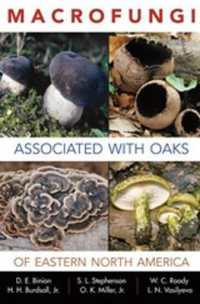Full Description
Research-based classroom and content strategies for the inclusive classroom.
The Inclusive Classroom: Strategies for Effective Differentiated Instruction , Sixth Edition captures the best of inclusion practices. Using a non-categorical approach, Mastropieri and Scruggs explain the fundamentals of inclusive teaching, the most effective general teaching practices, and ways to differentiate instruction for specific content areas. Targeted teaching strategies show ways to improve all students' memory, attention, motivation, study skills, and peer interaction. Research Highlights features validate strategies and demonstrate why particular techniques are best practice. Filled with classroom-ready tips and checklists, this revision includes an expanded chapter on Response to Intervention (RTI) and Multi-Tiered Systems of Support (MTSS), more coverage of the Common Core State Standards (CCSS) and Universal Design for Learning (UDL), and the latest strategies relating to academic success.Also available with MyLab EducationMyLabTM Education is an online homework, tutorial, and assessment program designed to work with the text to engage students and improve results. Within its structured environment, students see key concepts demonstrated through real classroom video footage, practice what they learn, test their understanding, and receive feedback to guide their learning and ensure they master key learning outcomes.Note: You are purchasing a standalone product; MyLab Education does not come packaged with this content. Students, if interested in purchasing this title with MyLab Education, ask your instructor to confirm the correct package ISBN and Course ID. Instructors, contact your Pearson representative for more information.
If you would like to purchase both the physical text and MyLab Education, search for:0134995716 / 9780134995717 The Inclusive Classroom: Strategies for Effective Differentiated Instruction, MyLab Education with Enhanced Pearson eText, and Loose-Leaf Version -- Access Card Package
Package consists of:
0134450434 / 9780134450438 The Inclusive Classroom: Strategies for Effective Differentiated Instruction -- MyLab Education Access Card
0134895029 / 9780134895024 The Inclusive Classroom: Strategies for Effective Differentiated Instruction
Contents
Brief Contents
PART 1 THE FUNDAMENTALS
Introduction to Inclusive Teaching
Collaboration: Partnerships and Procedures
Teaching Students with Higher-Incidence Disabilities
Teaching Students with Autism and Lower-Incidence Disabilities
Teaching Students with Other Special Learning Needs
PART 2 DEVELOPING EFFECTIVE TEACHING SKILLS
Effective Differentiated Instruction for All Students
Response to Intervention and Multi-Tiered Systems of Support
Improving Motivation and Social Behavior
Promoting Inclusion with Classroom Peers
Improving Attention and Memory
Teaching Study Skills
Assessment
PART 3 TEACHING IN THE CONTENT AREAS
Literacy
Mathematics
Science, Social Studies, and Transitions
PART 1 THE FUNDAMENTALS
CHAPTER 1: Introduction to Inclusive Teaching
LEARNING OUTCOMES
What Are the Educational Rights for Individuals with Disabilities?
The Least Restrictive Environment
Where Are Students with Disabilities Served?
Mainstreaming and Inclusion,
Who Is
Served Under IDEA?
Other Instances of Classroom Diversity,
Legal Foundations
Legal Proceedings and Legislation,
Section 504,
Americans with Disabilities Act,
Individuals with Disabilities Education Act (IDEA),
No Child Left Behind Act (NCLB) of 2001 and Every Student Succeeds Act (ESSA) of 2015,
Models of Service Delivery
The Continuum of Services,
Where Are Most Students with Disabilities Served?
What Are General Education Classroom and Consultation Services?
What Are Resource and Self-Contained Services?
Special Schools and Special Facilities,
What Other Related Services Are Available?
Full Inclusion,
What Does This Debate Mean for Teachers?
Teacher Attitudes,
SUMMARY
CHAPTER 2: Collaboration: Partnerships and Procedures
LEARNING OUTCOMES
Collaboration to Meet Students' Needs
Shared Goals,
Effective Communication
Strategies for Communicating Effectively,
Collaboration and Communication for Intervention
General Education Prereferral Request,
The Intervention Process,
Collaboration for Referrals and Placements
Collaboration as Partnerships
Consultation Between Special and General Educators,
Co-Teaching,
Strategies for Collaborating with Paraprofessionals,
Strategies for Collaborating Effectively with Parents and Families,
SUMMARY
INCLUSION CHECKLIST
CHAPTER 3: Teaching Students with Higher-Incidence Disabilities
LEARNING OUTCOMES
Speech or Language Impairments
Prevalence, Definitions, and Characteristics of Speech or Language Impairments,
Causes of Speech or Language Impairments,
Identification and Assessment of Speech or Language Impairments,
Strategies for Making Adaptations for Students with Speech or Language Impairments,
Learning Disabilities
Prevalence and Definitions of Learning Disabilities,
Causes of Learning Disabilities,
Issues in Identification and Assessment of Learning Disabilities,
Characteristics of Learning Disabilities,
Strategies for Making Classroom Adaptations for Students with Learning Disabilities,
Intellectual Disabilities
Prevalence and Definitions of Intellectual Disabilities,
Causes of Intellectual Disabilities,
Issues in Identification and Assessment of Intellectual Disabilities,
Characteristics of Intellectual Disabilities,
Strategies for Making Classroom Adaptations for Students with Intellectual Disabilities,
Emotional Disturbance
Prevalence and Definitions of Emotional Disturbance,
Causes of Emotional Disturbance,
Issues in Identification and Assessment of Emotional Disturbance,
Characteristics of Emotional Disturbance,
Strategies for Making Classroom Adaptations for Students with Emotional Disturbance,
Attention Deficit Hyperactivity Disorder (ADHD)
Definitions, Prevalence, and Characteristics of ADHD,
Causes of ADHD,
Issues in Identification and Assessment of ADHD,
Strategies for Making Classroom Adaptations for Students with Attention Deficit Hyperactivity Disorder,
SUMMARY
INCLUSION CHECKLIST
CHAPTER 4: Teaching Students with Autism and Lower-Incidence Disabilities
LEARNING OUTCOMES
Autism
Prevalence, Definitions, and Characteristics of Autism,
Strategies for Making Classroom Adaptations for Students with Autism,
Physical Disabilities and Other Health Impairments
Prevalence, Definitions, and Characteristics of Physical Disabilities and Other Health Impairments,
Physical and Health-Related Disabilities,
Strategies for Making Classroom Adaptations for Students with Physical Disabilities and Other Health Impairments,
Severe and Multiple Disabilities
Prevalence, Definitions, and Characteristics of Severe and Multiple Disabilities,
Strategies for Making Classroom Adaptations for Students with Severe and Multiple Disabilities,
Visual Impairments
Prevalence, Definitions, and Characteristics of Visual Impairments,
Strategies for Making Classroom Adaptations for Students with Visual Impairments,
Hearing Impairments Including Deafness
Prevalence, Definitions, and Characteristics of Hearing Impairments,
Educational Programming,
Strategies for Making Classroom Adaptations for Students with Hearing Impairments,
SUMMARY
INCLUSION CHECKLIST
CHAPTER 5: Teaching Students with Other Special Learning Needs
LEARNING OUTCOMES
Gifted, Creative, and Talented
Definitions, Prevalence, and Characteristics of Gifted, Creative, and Talented,
Issues in Identification and Assessment of Gifted, Creative, and Talented,
Strategies for Making Adaptations for Students Who Are Gifted, Creative, and Talented,
Students Who Are Culturally and Linguistically Diverse
Prevalence, Definitions, and Characteristics of Culturally and Linguistically Diverse
Students,
Issues in Identification and Assessment of Culturally and Linguistically Diverse Students,
Strategies for Making Adaptations for Students from Culturally and Linguistically Diverse Backgrounds,
Students at Risk
Definitions, Prevalence, and Characteristics of Students at Risk,
Coordinating Instruction with Compensatory Education Programs,
Strategies for Making Adaptations for Students at Risk,
SUMMARY
INCLUSION CHECKLIST
PART 2: DEVELOPING EFFECTIVE TEACHING SKILLS
CHAPTER 6: Effective Differentiated Instruction for All Students
LEARNING OUTCOMES
What Is Differentiated Instruction?
Promoting Effective Differentiated Instruction: The PASS Variables
P: Prioritize Instruction
Strategies for Planning for Content Coverage,
A: Adapt Instructional Methods, Instructional Materials, or the Learning Environment
Strategies for Making Adaptations,
S: Systematically Teach with the SCREAM Variables
Strategies for Implementing the SCREAM Variables,
Strategies for Maximizing On-Task Behavior,
Strategies for Maximizing Time for Learning,
S: Systematically Evaluate the Outcomes of Your Instruction
Strategies for Promoting Systematic Evaluation of Instruction,
Putting the PASS Variables to Work: Including Model Lesson Components in Instruction
SUMMARY
INCLUSION CHECKLIST
CHAPTER 7: Response to Intervention and Multi-Tiered Systems of Support
LEARNING OUTCOMES
What Is RTI?
Schoolwide Screening, Progress Monitoring, and Data-Based Decision Making
Strategies for Administering Schoolwide Screening,
Strategies for Progress Monitoring and Data-Based Decision Making,
Tier 1: Effective Instruction in General Education
Features of Tier 1 Instruction,
Strategies for Implementation of Tier 1 Instruction,
Tier 2: Intervention to Remediate
Features of Tier 2 Instruction,
Strategies for Implementation of Tier 2 Instruction,
Considerations in Implementation of Tier 2 Instruction,
Tier 3: Individualized, Intensive Instruction
Strategies for Implementation of Tier 3 Instruction,
Fidelity of Implementation
Strategies for Determining Fidelity of Implementation,
Strategies for Implementing RTI at The Secondary Level,
Challenges with Implementing RTI
SUMMARY
INCLUSION CHECKLIST
CHAPTER 8: Improving Motivation and Social Behavior
LEARNING OUTCOMES
Setting the Stage for Academic Success
Strategies for Improving Motivation and Affect,
Improving Classroom Behavior and Social Skills
Managing Classroom Behavior,
Strategies for Observing and Recording Classroom Behavior,
Strategies for Using Effective Classroom Management Methods,
Strategies for Less-Intensive Classroom Management Methods,
Strategies for More Formal Classroom Management Methods,
Strategies for Handling Classroom Confrontations,
Strategies for Implementing Schoolwide Discipline Systems,
Strategies for Confronting Bullying,
Teaching Social Skills
Strategies for Social Skills Training,
SUMMARY
INCLUSION CHECKLIST
CHAPTER 9: Promoting Inclusion with Classroom Peers
LEARNING OUTCOMES
Peer-Supported Social Acceptance
Strategies for Promoting Social Acceptance,
Peer Assistance
Strategies for Enlisting Peer Assistance,
Peer Tutoring
Benefits of Peer Tutoring,
Strategies for Implementing a Tutoring Program,
Strategies for Promoting Learning with Classwide Peer Tutoring,
Cooperative Learning
Strategies for Implementing Cooperative Learning,
Advantages and Challenges of Cooperative Learning,
SUMMARY
INCLUSION CHECKLIST
CHAPTER 10: Improving Attention and Memory
LEARNING OUTCOMES
Attention
Attention and Students with Special Needs,
Strategies for Improving Attention,
Strategies for Addressing Extreme Cases of Attention Deficits,
Memory
Strategies for Improving Memory,
Strategies for Improving Memory with Mnemonic Techniques,
SUMMARY
INCLUSION CHECKLIST
CHAPTER 11: Teaching Study Skills
LEARNING OUTCOMES
Tools for Developing Independent Learners
Strategies for Developing Personal Organizational Skills,
Strategies for Promoting Listening Skills,
Strategies for Teaching Note-Taking Skills,
Research and Reference Skills
Strategies for Teaching Library Skills,
Strategies for Preparing Reports and Projects,
SUMMARY
INCLUSION CHECKLIST
CHAPTER 12: Assessment
LEARNING OUTCOMES
Types of Tests
Performance Assessments and Portfolio Assessments,
Adapting Tests for Students with Special Needs
Strategies for Administering Norm-Referenced Tests,
Strategies for Adapting Competency-Based Local and Statewide Assessment,
Strategies for Adapting Teacher-Made and Criterion-Referenced Tests,
Strategies for Using Curriculum-Based
Measurement,
Strategies for Using Performance Assessment,
Strategies for Using Portfolio Assessment,
Teach Test-Taking Skills
Strategies for Teaching Test-Taking Skills,
Grading
Strategies for Adapting Report Card Grading,
SUMMARY
INCLUSION CHECKLIST
PART 3: TEACHING IN THE CONTENT AREAS
CHAPTER 13: Literacy
LEARNING OUTCOMES
Approaches to Reading
Strategies for Implementing Approaches to Reading,
Common Core State Standards in Reading
Teaching Reading Skills
Strategies for Promoting Word Identification,
Strategies for Promoting Reading
Fluency,
Reading Comprehension
Strategies for Teaching Reading Comprehension,
Strategies for Implementing Multi-Tiered Reading Instruction with RTI,
Written Expression
Strategies for Improving Handwriting,
Strategies for Teaching Spelling,
Strategies for Teaching Written Communication,
SUMMARY
INCLUSION CHECKLIST
CHAPTER 14: Mathematics
LEARNING OUTCOMES
Mathematics Education
Mathematics and Students with Disabilities
Teaching Math in Inclusive Settings
Strategies for Teaching Beginning Math,
Strategies for Teaching Addition and Subtraction,
Strategies for Teaching Multiplication and Division,
Strategies for Teaching Problem Solving,
Strategies for Teaching About Money and Time,
Strategies for Teaching Fractions and Decimals,
Strategies for Teaching Area and Volume Concepts,
Strategies for Teaching Algebra,
Strategies for Teaching Functional Math,
SUMMARY
INCLUSION CHECKLIST
CHAPTER 15: Science, Social Studies, and Transitions
LEARNING OUTCOMES
Adapting Textbook-Oriented Approaches in Science and Social Studies
Common Core State Standards Relevant to Science and Social Studies,
Strategies for Effective Teaching in Science and Social Studies,
Strategies for Promoting Independent Learning from Textbooks,
Strategies for Adapting Textbook Materials,
Adapting Activities-Oriented Approaches in Science and Social Studies
Strategies for Adapting Science Activities,
Strategies for Adapting Life Science Activities,
Strategies for Adapting Earth Science Activities,
Strategies for Adapting Physical Science Activities,
Strategies for Adapting Social Studies Activities,
Inquiry Learning in Science and Social Studies
Strategies for Adapting Inquiry Learning Activities,
Transitions
Planning for Transition,
Strategies for Promoting Transitions,
Strategies for Transitioning for the Future,
SUMMARY
INCLUSION CHECKLIST
REFERENCES NAME INDEX SUBJECT INDEX








